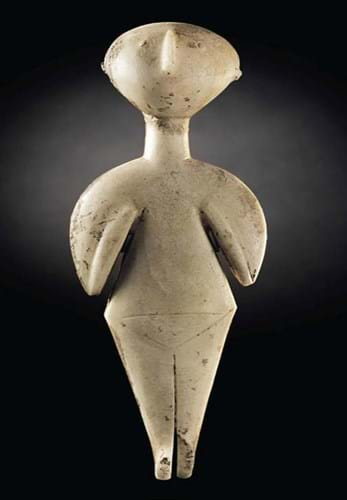
Just prior to the April 28 sale in New York, culture minister Nabi Avci told journalists in Istanbul that he believed the piece – made in Anatolia c.3000-2200 BC – had been illegally excavated and smuggled to the US.
“We’ve taken steps in order to stop the sale of this work of art and inform the possible recipient that this was abducted from Turkey,” he said.
The claim was rejected by a US District Court judge who gave Christie’s permission to proceed with the sale.
Estimated at $3m, it sold at $12.5m/£9.69m ($14.5m/£11.24m including premium).
However, the auctioneer was told by the court it could not hand over the idol to the buyer until a final decision was made 60 days after the auction. Christie’s says it will not require payment until that time and added “if the buyer is not satisfied with the terms of the sale they shall have a right of cancellation”.
On loan
The so-called ‘Guennol Stargazer’ – at 9in (22cm) high, exceptional in size, quality and condition – had been on loan to the Metropolitan Museum for 27 years and was documented in the US for more than 50 years. Christie’s vendor was a US private collector who had bought it from the Merrin Gallery, New York, in August 1993.
Previously, New Yorkers Alastair and Edith Martin, who began the Guennol collection of ancient works of art in 1947, had owned it since 1966 or earlier.
This places it on US soil comfortably before the 1970 cut-off date set by the UNESCO Convention but after the date applied in the cultural property laws that have operated in Turkey since the days of the Ottoman Empire. A 1906 statute decreed that all antiquities found on private or public land were state property.
The Turkish government’s task will be to prove the ‘stargazer’ was unearthed within its national boundaries and was not among the many Turkish antiquities that, while subject to control, were deemed not worth keeping in the country.
“We are going to present the necessary scientific reports showing the statute belongs to Turkey within the two-month time frame the court gave us,” the minister said.
The Turkish ministry of culture and tourism took a full page advert in the New York Times, picturing an Anatolian stargazer alongside an article urging Americans and Turkey to ‘work together to preserve the archaeological record’.
Kiliya type idols
Anatolian marble idols from the Chalcolithic period c.3000-2200 BC are interchangeably referred to as ‘Kiliya type’ and stargazers.
Kiliya refers to the town on the Gallipoli peninsula where the first published example was discovered, with ‘stargazer’ the colloquial title derived from the angle at which the massive head rests on the slender neck. Like their ‘cousins’ from Cycladic Greece – another form so influential in the Modern art movement – the original function of the idols remains a mystery but they may relate to fertility.
Most of the 15 or so known complete examples – including the Guennol Stargazer – have been broken across the neck, suggesting that the sculptures were ritually ‘killed’ at the time of burial. The last example to appear at auction, the 8in (20cm) Schuster Stargazer, sold at Christie’s New York in June 2005 for $1.8m.














